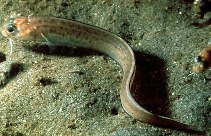| Family: |
Ophidiidae (Cusk-eels), subfamily: Ophidiinae |
| Max. size: |
40.4 cm TL (male/unsexed) |
| Environment: |
demersal; brackish; marine; depth range 0 - 280 m |
| Distribution: |
Eastern Pacific: Washington, USA to Baja California and Ecuador. Record from the Gulf of California is doubtful. |
| Diagnosis: |
Dorsal spines (total): 0-0; Dorsal soft rays (total): 187-229; Anal spines: 0-0; Anal soft rays: 150-181; Vertebrae: 86-91. Head naked; scales on body in basketweave pattern; precaudal vertebrae 18-19; swim bladder in males with posterior opening; body and head with numerous dark spots and blotches (Ref. 34024). Branchiostegal rays: 7 (Ref. 36413). Pelvic fin consists of one ray with two branches of unequal length (Ref. 36413). |
| Biology: |
Uncommon species found on sandy bottom from the shore to 280 m (Ref. 34024). Adults often burrow tail-first in sand, live in mucus-lined holes (Ref. 2850), mud, eelgrass and rock rubble (Ref. 36413). Mostly active at night and on overcast days (Ref. 2850). Important food for sea lions and cormorants (Ref. 2850). Oviparous, with planktonic larvae and extended pelagic juvenile (Ref. 36413). Oval, pelagic eggs float in a gelatinous mass (Ref. 205). |
| IUCN Red List Status: |
Least Concern (LC); Date assessed: 23 May 2007 Ref. (130435)
|
| Threat to humans: |
harmless |
| Country info: |
|
Source and more info: www.fishbase.org. For personal, classroom, and other internal use only. Not for publication.

